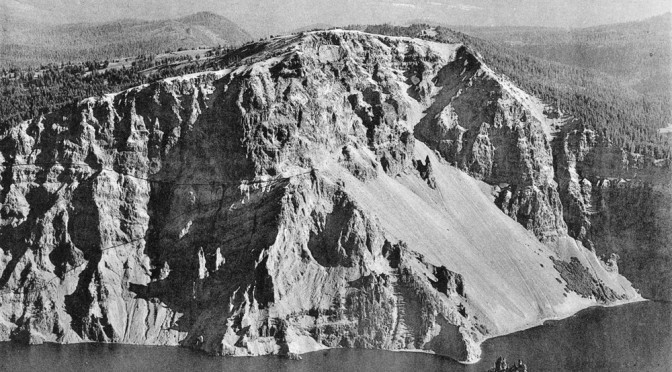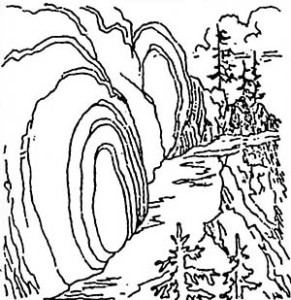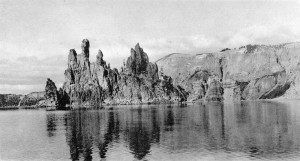|
Example of “spheroidal weathering” along the Garfield Peak Trail, Nature Notes from Crater Lake, 7:2, August 1934, The Geology of the Garfield Trail – C. R. Swartzlow. |
At almost every point around the Lake may be seen steep slopes of loose material which seems to have slid down from the Rim. These are known as talus slopes and are the result of weathering of the lavas, causing slide material to accumulate at the greatest angle of repose.
The action of the rain and air on the materials composing the talus has caused their iron content to reach several stages of oxidation. In other words, the rocks have rusted and the tints of yellow, red, brown, and gray tell a story of varying oxygen content.
A very striking example of this is seen in the wide talus slope beneath the pinnacles of The Watchman and Hillman Peak, southwest of Wizard Island. These peaks are themselves the result of the erosional activities of weathering. In connection with weathering activities it will be observed that the plant life along the Rim both aids and prevents erosion. Erosion is speeded up by growing plants which send their roots into the joints of the lava beds and break them off by the pressure exerted. The life processes cause plants to generate certain acids which help break down the rocks by chemical action. [The Geology of Wizard Island – Hugh H. Waesche, Vol. 7, No. 1, 1934]
Weather Articles in Nature Notes From Crater Lake
- Cave – D. S. Libbey, Vol. 5, No. 3, 1932
- Llao’s Hallway – Warren G. Moody, Vol. 6, No. 2, 1933
- Understanding the Bimodal Eruptions of Mount Mazama – Brandon L. Browne, Vol. 29, 1998
- The Geology of the Garfield Trail – C. R. Swartzlow, Vol. 7, No. 2, 1934
- Nivation – D. S. Libbey, Vol. 15, No. 1, 1949
|
Definition (Weathering) The decomposition of rocks, soils and their minerals through direct contact with the atmosphere. Weathering occurs in place, with no movement, thus, should not be confused with erosion, which involves the movement of rocks and minerals by agents such as water, ice, wind, and gravity. Mechanical or physical weathering involves the breakdown of rocks and soils through direct contact with atmospheric conditions, such as heat, water, ice, and pressure. Chemical weathering involves the direct effect of atmospheric chemicals or biologically produced chemicals (also known as biological weathering) in the breakdown of rocks, soils, and minerals. The materials left over after the rock breaks down combined with organic material creates soil. The mineral content of the soil is determined by the parent material – Wikipedia: Weathering |
Other pages in this section
*** previous title *** --- *** next title ***




